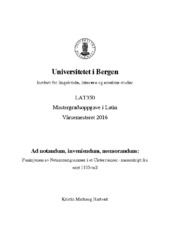| dc.description.abstract | The subject of my Master thesis is the function of Nota-signs in the margins of a late 12th century manuscript, Ms.28, owned by the Library of the University of Bergen. The signs in question are 107 monograms of the word Nota, along with a small number of similar signs that can all be grouped together under that term. The research question of my thesis has been as follows: What is the function of the Nota-marks in Ms.28, and what can they tell us about the manuscript? Also, as no thorough description of Ms.28 existed when I started my research, I added the following: How could Ms.28 best be described to give a good understanding of it as a whole? Methods: I have used three main points of departure for my research: Nota-signs as guides to understanding the text; as tools for searching for information within a manuscript; and as aids for memorizing text. I have aimed to show that this kind of investigation is worthwhile, as it may provide information about how manuscripts were actually used. Little research has been done in this field, and as far as I know there are no papers or books concerned solely with the use of Nota-signs, nor any large-scale examinations of local or temporal varieties., Yet, I have found valuable information in texts by Kirsten Berg, Mary Carruthers, Neil Ker, Henry Mayr-Harting, and Teresa Webber, among others. They all treat these signs in some way or other, and their methods have proven very useful. Materials: The manuscript itself, Ms.28, contains commentaries by Jerome on the gospel of Matthew and four of the Pauline Epistles. It is very well preserved, it's original binding still intact, and the writing and decoration is of high quality. It was made at the Cistercian Abbey of St. Mary at Cambron in Belgium, and was finished in the year 1200 - we know this because of a colophon made by the scribe, who also named himself Ulbaldus. There is one more manuscript known to have been written by him, because of a similar colophon. It's shelfmark is Add.Ms.15218, and it belongs the British Library, who kindly allowed me to see it on two occasions. I also looked at three other manuscripts in their collection from the same place and period: Add. Ms. 21093, Add.Ms.22797 and Egerton 631. These have been used for comparison, and have been very useful as such. The British Library have also provided me with images from all manuscripts, and they are reproduced here by their permission. Results: Based on my research it seems that the Nota-signs in Ms.28 can be viewed through all of the starting-points, but some more than others. As markers of text, they highlight information that would be important to notice, such as explanations of concepts in the Bible, warnings against sin, heresy and excessive penance, and ways to achieve salvation. Thus, the signs could also be used to make certain the readers didn't misunderstand anything important. The second, that it could be used as a tool for searching, seems less likely. They don't seem to be part of the searching tools developed during the 12th century, and the use of Nota-monograms receded as the new tools gained ground. Thus, they probably weren't meant as such,, even though they may still have been used that way. The last, Nota-signs used as aids to memory, seems more likely. Signs like these could very well have that kind of purpose, given the visual nature of medieval memory-training. Also, in Ms.28 they often mark proverbs and short, epigrammatic sentences, that should be an easier way to remember the more complex parts of Jerome’s commentaries. Given the lack of research in this field, I have found it difficult to give any clear conclusions, as there isn’t enough to back it up with. Still, I have been able to give what I see as reasonable suggestions. Also, the Nota-signs have provided interesting information about the scribe (through comparison with similar signs in Add.Ms.15218), and several possibilities to how Ms.28 was meant to be and has been used. All in all, it illustrates that there is a lot of work yet to be done on the subject, and I will follow it’s progress with interest. | en_US |
